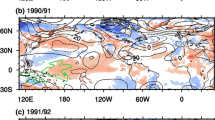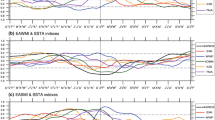Summary
Pentad mean anomaly maps were used to study the climatology of tropical intraseasonal convection anomaly (TICA) as a dynamic system. One hundred and twenty-two events were identified and classified into three categories: eastward (77), independent northward (27), and westward (18) propagation. The eastward propagation is more active in boreal winter than in summer, while the independent northward propagation, which is not associated with equatorial eastward propagation, occurs in boreal summer from May to October.
The eastward moving TICA exhibits three major paths: 1) eastward along the equator from Africa to the mid-Pacific, 2) first eastward along the equator, then either turning north-east to the northwest Pacific or turning southeast to the southwest Pacific at the maritime continent, and 3) the main anomaly moves eastward along the equator with split center(s) moving northward over the Indian and/or western Pacific Oceans. The equatorial Indian Ocean and the western Pacific intertropical convergence zone are preferred geographic locations for their development, while the maritime continent and central Pacific are regions of dissipation.
Independent northward propagation is confined to the Indian and western Pacific monsoon regions. Its existence suggests that the mechanism responsible for meridional propagation may differ from that for eastward propagation.
The dynamic effect of the equator and the thermodynamic effect of the underlying warm ocean water are basic factors in trapping TICA in the deep tropics, while the annual march of maximum SST (thermal equator) and the monsoon circulation have profound influences on the annual variation and meridional movement of TICA.
Similar content being viewed by others
References
Julian, P. R., Madden, R. A., 1981: Comments on a paper by T. Yasunari, A quasi-stationary appearance of 30 to 40 day period in the cloudiness fluctuation during the summer monsoon over India.J. Meteor. Soc. Japan,59, 435–437.
Krishnamurti, T. N., Subrahmanyam, D., 1982: The 30–50 day mode at 850 mb during MONEX.J. Atmos. Sci.,39, 2088–2095.
Krishnamurti, T. N., Jayakumar, P. K., Sheng, J., Surgi, N., Kumar, A., 1985: Divergent circulations on the 30–50 daytime scale.J. Atmos. Sci.,42, 364–375.
Lau, K.-M., Chan, P. H., 1985: Aspects of the 40–50 day oscillation during the northern winter as inferred from outgoing wave radiation.Mon. Wea. Rev.,113, 1889–1909.
Lau, K.-M., Chan, P. H., 1988: Intraseasonal and interannual variations of tropical convection: A possible link between the 40–50 day oscillation and ENSO?.J. Atmos. Sci.,45, 506–521.
Lorenc, A. C., 1984: The evolution of planetary-sale 200 mb divergent flow during the FGGE year.Quart. J. Roy. Meteor. Soc.,110, 427–441.
Madden, R. A., 1986: Seasonal variation of the 40–50 day oscillation in the tropics.J. Atmos. Sci.,43, 3138–3158.
Madden, R. A., Julian, P. R., 1971: Detection of a 40–50 day oscillation in the zonal wind in the tropical Pacific.J. Atmos. Sci.,28, 702–708.
Madden, R. A., Julian, P. R., 1972: Description of global-scale circulation cells in the tropics with a 40–50 day period.J. Atmos. Sci.,29, 1109–1123.
Murakami, T., Nakazawa, T., 1985: Tropical 45 day oscillations during the 1979 Northern Hemisphere summer.J. Atmos. Sci.,42, 1107–1122.
Murakami, T., Chen, L.-X., Xie, A., 1986: Relationship among seasonal cycle, low-frequency oscillation, and transient disturbance as reavealed from outgoing longwave radiation data.Mon. Wea. Rev.,114, 1456–1465.
Rui, H.-L., Wang, B., 1990: Evolution characteristics and dynamic structure of tropical intraseasonal convection anomalies.J. Atmos. Sci.,47, 357–379.
Wang, B., Rui, H.-L., 1990: Dynamics of the coupled moist Kelvin-Rossby wave on an equatorial beta-plane.J. Atmos. Sci.,47, 397–413.
Weickmann, K. M., Lussky, G. R., Kutzbach, J. E., 1985: Intraseasonal (30–60) fluctuations of outgoing longwave radiation and 250 mb streamfunction during northern winter.Mon. Wea. Rev.,112, 941–964.
Weickmann, K. M., Khalsa, S. J. S., Steiner, E. J., 1990: The shift of convection from the Indian Ocean to the western Pacific Ocean during a 30–60 day oscillation.Mon. Wea. Rev.,118, 964–978.
Yasunari, T., 1979: Cloudiness fluctuation associated with the Northern Hemisphere summer monsoon.J. Meteor. Soc. Japan. 57, 227–241.
Author information
Authors and Affiliations
Additional information
With 12 Figures
Contribution No. 89-11, Department of Meteorology, University of Hawaii.
Rights and permissions
About this article
Cite this article
Wang, B., Rui, H. Synoptic climatology of transient tropical intraseasonal convection anomalies: 1975–1985. Meteorl. Atmos. Phys. 44, 43–61 (1990). https://doi.org/10.1007/BF01026810
Received:
Revised:
Issue Date:
DOI: https://doi.org/10.1007/BF01026810




